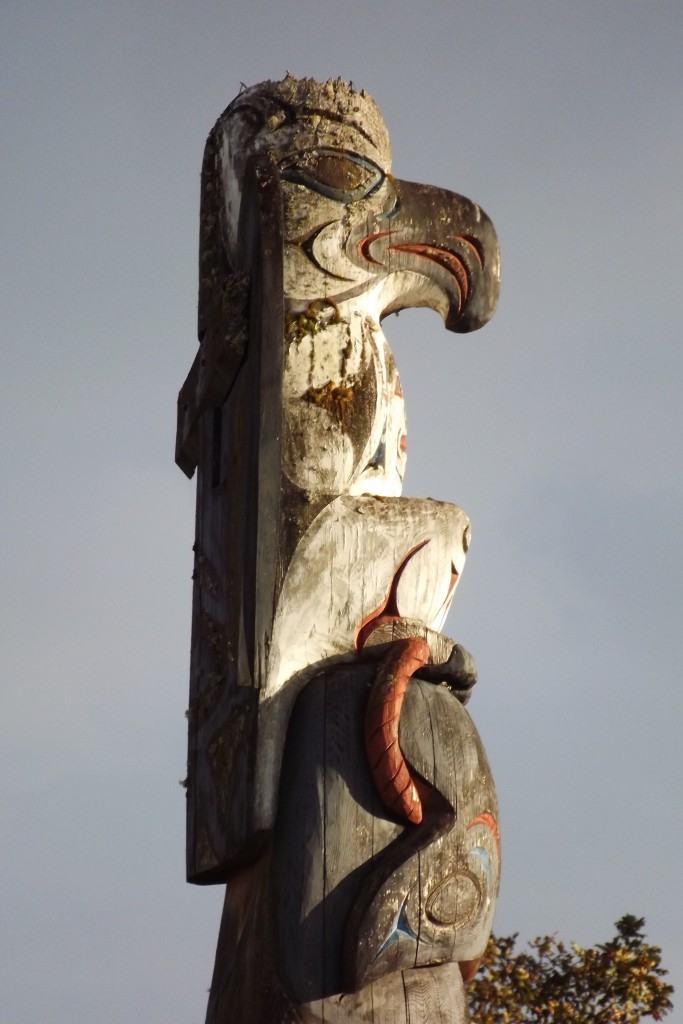 At the end of the Victoria trip, dg spent an afternoon with the Coast Salish master carver Charles W. Elliott in his studio at the Tsarlip First Nation Reserve on the Saanich Peninsula north of the city. Above is a thunderbird atop of a Charles Elliott totem pole in front of the ȽÁU, WELṈEW̱ Tribal High School just down the road from the studio.
At the end of the Victoria trip, dg spent an afternoon with the Coast Salish master carver Charles W. Elliott in his studio at the Tsarlip First Nation Reserve on the Saanich Peninsula north of the city. Above is a thunderbird atop of a Charles Elliott totem pole in front of the ȽÁU, WELṈEW̱ Tribal High School just down the road from the studio.
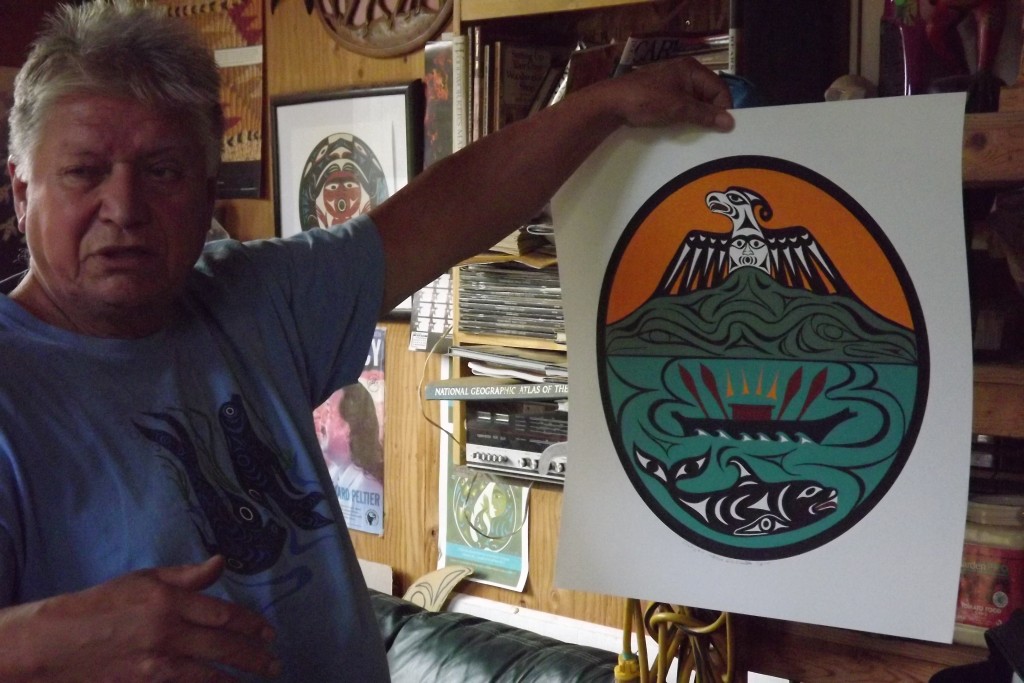 Charles W. Elliott holding a print he designed as a symbol for the University of Victoria Indigenous Governance program.
Charles W. Elliott holding a print he designed as a symbol for the University of Victoria Indigenous Governance program.
Still processing this visit. Charles Elliott is an amazingly generous and intelligent artist, very articulate and personable. He took a lot of time to describe what he does. Coast Salish art is a formalist invention (which, naturally, makes is tremendously interesting to me) — he called it the Salish “system” — that involves the use of a finite set of motifs (e.g. thunderbird, raven, orca, etc.) and design elements (eyes, bracket shapes, lanceolate shapes, etc.). Often the smaller formal elements are fitted into a larger form that derives from a utilitarian space (house fronts, paddles, spoons, bowls, etc.). The print above, for example, is circular, a shape derived from the spindle whorl used by the native women to process wool. The artist fits larger motifs into the overall form and then fills the blank spaces with either smaller versions of a motif (or in inversion) or with repetitions of the abstract design elements. For example, the thunderbird wings contain eyes, brackets and lanceolate shapes. Beneath the thunderbird is an orca, and you can see the bracket shapes used down the whale’s back. The idea, Elliott says, is to bring the spaces “to life.” The large motifs refer to legends, myths, and powers (also, in some cases, clan and social organization elements), so they carry story and meaning to the viewer. But at the same time there is a purely design aspect to the art, a pleasing abundance and vivacity of structure. What’s truly interesting is how the abstract design elements can be used to imply naturalistic details (see the shins on the thunderbird’s legs).
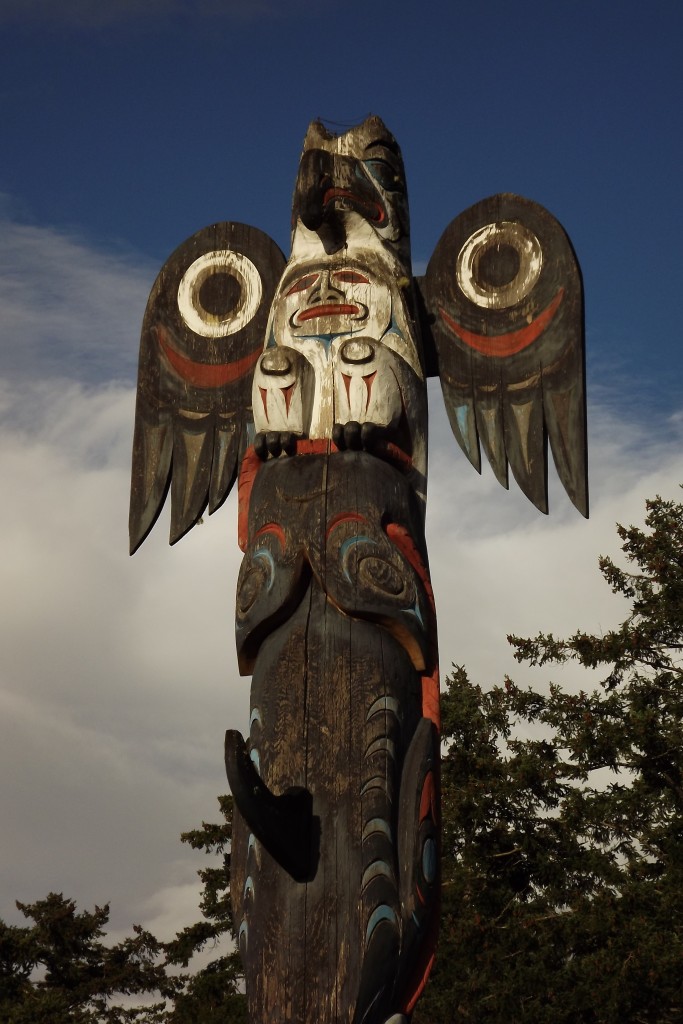
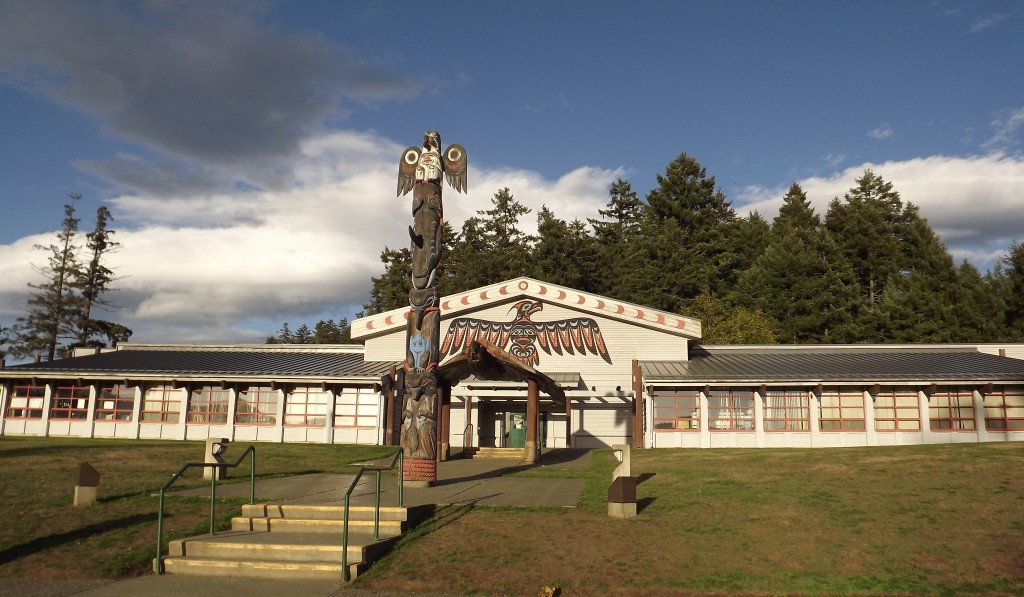 Here’s the school front. Note the repetition of the structure: thunderbird on top of the pole, thunderbird on the from wall of the building, and the structure of the building as a whole is a thunderbird with wings. What you can’t see from the angle is that before the front door is an entryway in the shape of a bird again. To get into the school, students pass beneath the thunderbird’s wings. Also not the bracket shapes along the roof line. And then think what a lively public art form this is.
Here’s the school front. Note the repetition of the structure: thunderbird on top of the pole, thunderbird on the from wall of the building, and the structure of the building as a whole is a thunderbird with wings. What you can’t see from the angle is that before the front door is an entryway in the shape of a bird again. To get into the school, students pass beneath the thunderbird’s wings. Also not the bracket shapes along the roof line. And then think what a lively public art form this is.
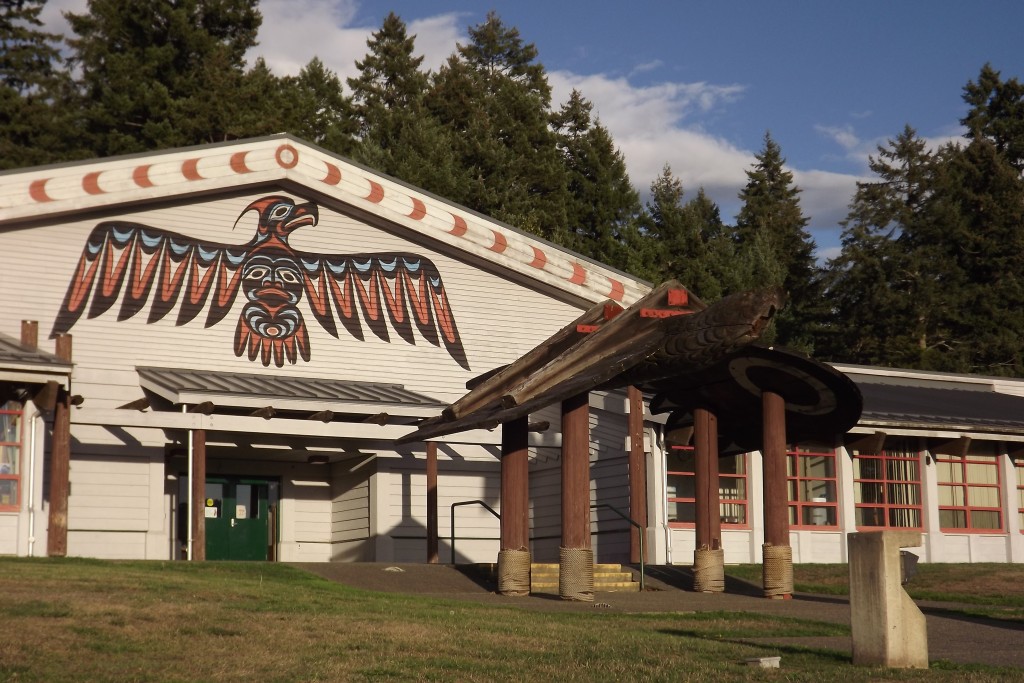
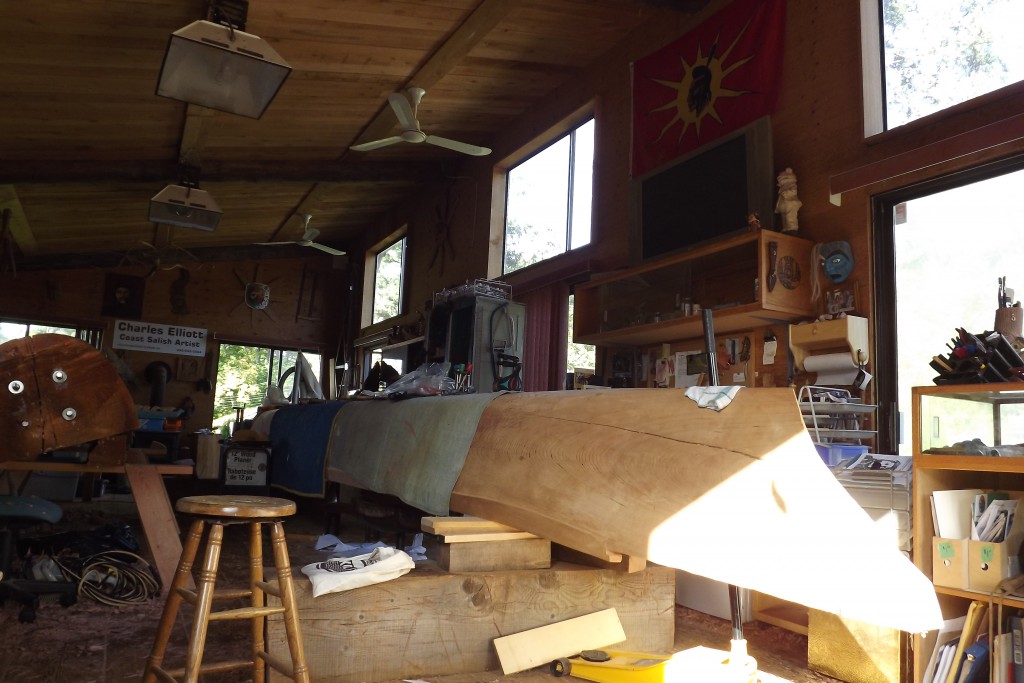 This is Elliott’s studio with a huge ocean-going dugout canoe made of old growth cedar, a work in progress. On the left is the base of a new totem pole.
This is Elliott’s studio with a huge ocean-going dugout canoe made of old growth cedar, a work in progress. On the left is the base of a new totem pole.
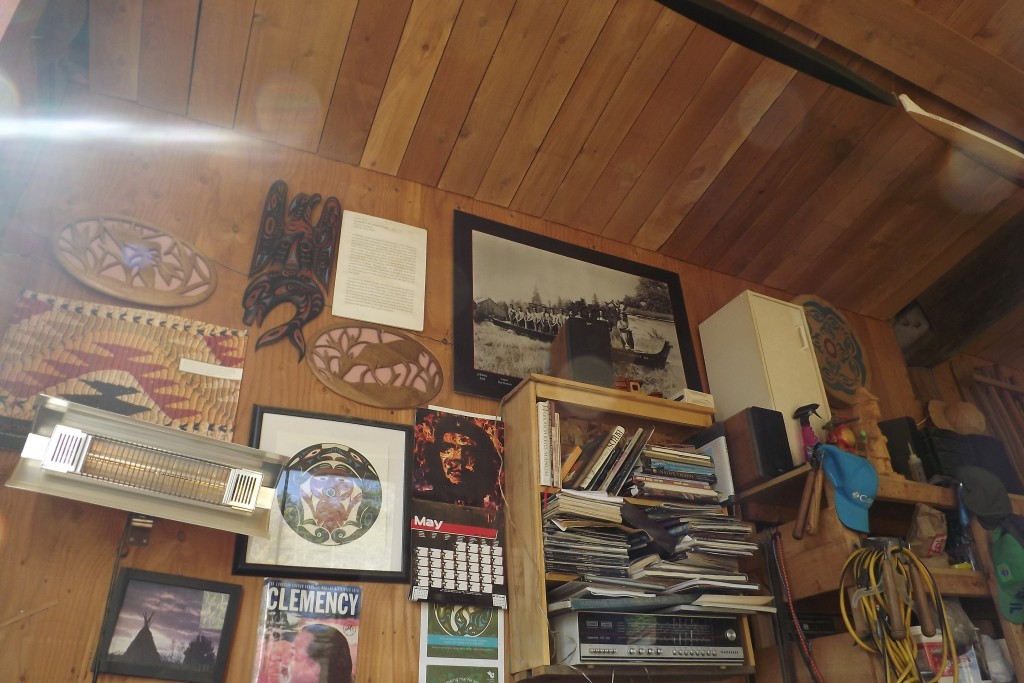 Studio again. Note the Che Guevara image, one of several, in the studio, also mentioned by Elliott. You can’t forget that the natives are a colonized and dispossessed people who wake up every morning and look around and see commuters racing up the highway to a city that covers the land that was once theirs spiritually and economically, land they never gave away in any sense proper to their own culture and way of thinking. Put yourself in their shoes. As Elliott said, it’s as if there is a constant cloud or blanket of colonization over the natives. How they could they forget and be pleased?
Studio again. Note the Che Guevara image, one of several, in the studio, also mentioned by Elliott. You can’t forget that the natives are a colonized and dispossessed people who wake up every morning and look around and see commuters racing up the highway to a city that covers the land that was once theirs spiritually and economically, land they never gave away in any sense proper to their own culture and way of thinking. Put yourself in their shoes. As Elliott said, it’s as if there is a constant cloud or blanket of colonization over the natives. How they could they forget and be pleased?
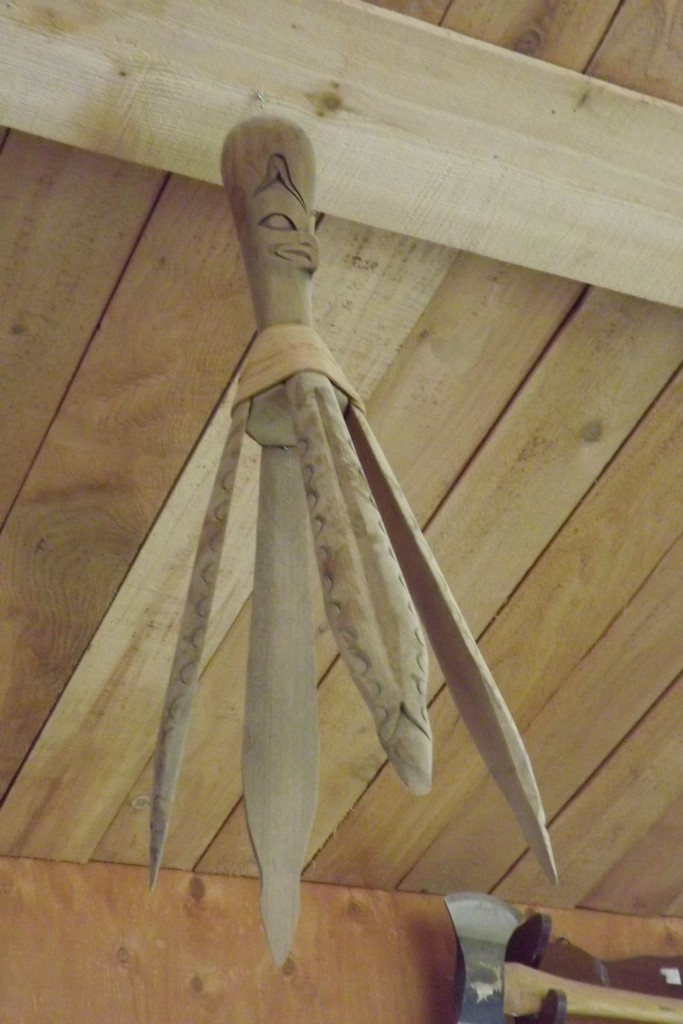 Little things all over the studio. Here’s a spinning fish lure in the shape of an octopus, the legs scalloped with those bracket patterns. Everything comes to life in this art world, inanimate objects, utilitarian objects.
Little things all over the studio. Here’s a spinning fish lure in the shape of an octopus, the legs scalloped with those bracket patterns. Everything comes to life in this art world, inanimate objects, utilitarian objects.
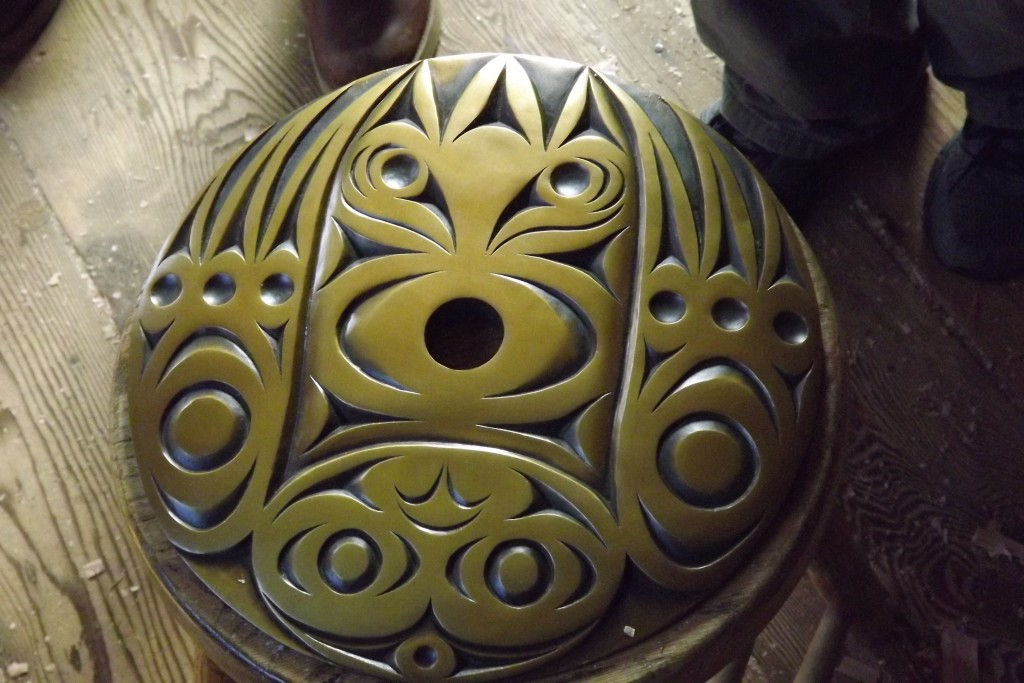 So here’s a bronze spindle whorl (traditionally they were made of wood) made by Elliott’s 19-year-old son, Chas Elliott, who is learning the art from his father and brought this over to show us. If I remember correctly this is a seal (but I heard so much I might be misremembering). Mouth in the spindle opening. Flippers or paws to the side. Flippers accented with eye and bracket and lanceolate shapes. Here’s a link to show where both father and son appeared a couple of years ago.
So here’s a bronze spindle whorl (traditionally they were made of wood) made by Elliott’s 19-year-old son, Chas Elliott, who is learning the art from his father and brought this over to show us. If I remember correctly this is a seal (but I heard so much I might be misremembering). Mouth in the spindle opening. Flippers or paws to the side. Flippers accented with eye and bracket and lanceolate shapes. Here’s a link to show where both father and son appeared a couple of years ago.
 DG with a “talking stick” (you would hand this to someone who would then hold the floor whole others listened). By now you should be able to distinguish some of the motifs and design elements.
DG with a “talking stick” (you would hand this to someone who would then hold the floor whole others listened). By now you should be able to distinguish some of the motifs and design elements.
 Outside the studio looking at a totem pole in for repair after about 20 years in the field. Totem poles don’t last forever, obviously. This one needs to be shaved down to fresh wood and repainted. And there is some rot at the top that needs digging out and a plug put in. A sad thing is that native carvers like Elliott can only work with old growth timber. For some reason, the old growth trees grew slower, their tree rings are much closer together, and the wood is harder and more durable. Newer trees seem to grow faster (perhaps because they get more light), the rings are farther apart and the wood between is “punky.” There is hardly any old growth timber left. I won’t go on. This is just a taste of the visit with Elliott, an immense privilege, not to mention fascinating; I could go on and on.
Outside the studio looking at a totem pole in for repair after about 20 years in the field. Totem poles don’t last forever, obviously. This one needs to be shaved down to fresh wood and repainted. And there is some rot at the top that needs digging out and a plug put in. A sad thing is that native carvers like Elliott can only work with old growth timber. For some reason, the old growth trees grew slower, their tree rings are much closer together, and the wood is harder and more durable. Newer trees seem to grow faster (perhaps because they get more light), the rings are farther apart and the wood between is “punky.” There is hardly any old growth timber left. I won’t go on. This is just a taste of the visit with Elliott, an immense privilege, not to mention fascinating; I could go on and on.
—DG, photos mostly by MF
Thanks for this, DG. His work is stunning! I love the repetition of motifs and the strong sense of design.
Gorgeous art—concise and expressive. Please pass on word to Charles & son.
Thanks, Gary. I’ll pass the word along. There was so much more to tell.
Fascinating…